新人教版英语九年级上册Unit 6 When was it invented 表格式教案5
- 格式:doc
- 大小:45.00 KB
- 文档页数:4
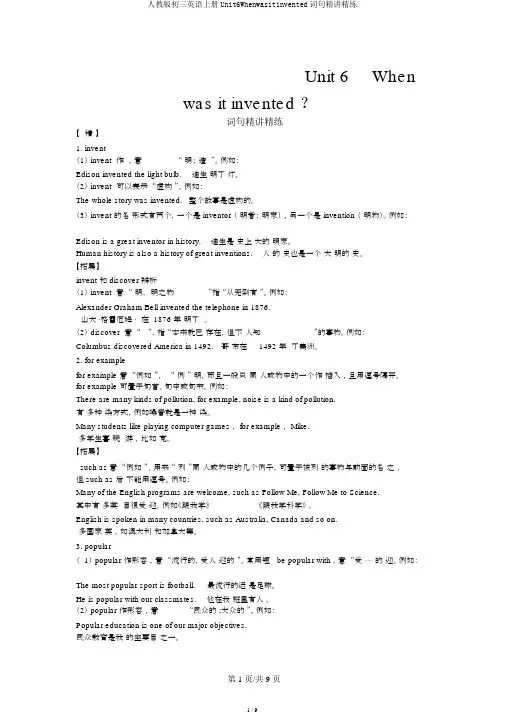
Unit 6 Whenwas it invented ?词句精讲精练【精】1. invent(1) invent 作,意“ 明;造”。
例如:Edison invented the light bulb.迪生明了灯。
(2) invent 可以表示“虚构”。
例如:The whole story was invented.整个故事是虚构的。
(3) invent 的名形式有两个,一个是 inventor (明者;明家),另一个是 invention (明物)。
例如:Edison is a great inventor in history.迪生是史上大的明家。
Human history is also a history of great inventions.人的史也是一个大明的史。
【拓展】invent 和 discover 辨析(1) invent 意“ 明,明之物”指“从无到有”。
例如:Alexander Graham Bell invented the telephone in 1876.山大·格雷厄姆· 在 1876 年明了。
(2) discover 意“ ”,指“本来就已存在,但不人知”的事物。
例如:Columbus discovered America in 1492.哥布在1492 年了美洲。
2. for examplefor example 意“例如”,“ 例” 明,而且一般只同人或物中的一个作插入,且用逗号隔开。
for example 可置于句首、句中或句末。
例如:There are many kinds of pollution, for example, noise is a kind of pollution.有多种染方式,例如噪音就是一种染。
Many students like playing computer games , for example , Mike.多学生喜玩游,比如克。
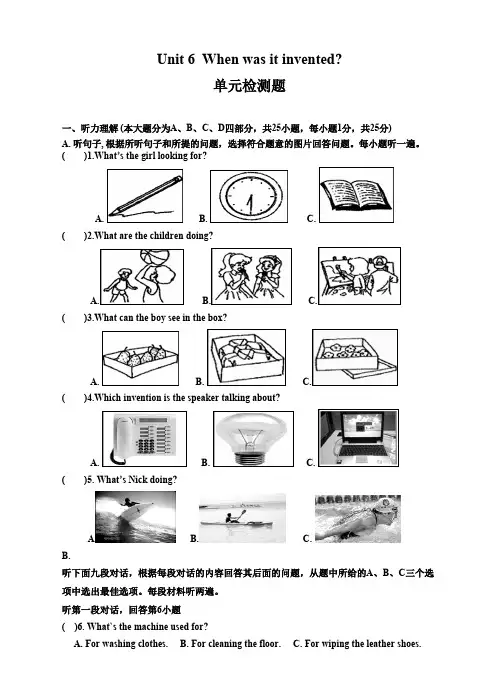
Unit 6 When was it invented?单元检测题一、听力理解 (本大题分为A、B、C、D四部分,共25小题,每小题1分,共25分)A. 听句子, 根据所听句子和所提的问题,选择符合题意的图片回答问题。
每小题听一遍。
( )1.What’s the girl looking for?A. B. C.( )2.What are the children doing?A. B. C.( )3.What can the boy see in the box?A. B. C.( )4.Which invention is the speaker talking about?A. B. C.( )5. What’s Nick doing?A B. C.B.听下面九段对话,根据每段对话的内容回答其后面的问题,从题中所给的A、B、C三个选项中选出最佳选项。
每段材料听两遍。
听第一段对话,回答第6小题( )6. What`s the machine used for?A. For washing clothes.B. For cleaning the floor.C. For wiping the leather shoes.听第二段对话,回答第7小题( )7. What does the man think of the light bulb?A. It makes us work late every day.B. It helps us live an interesting life.C. It makes the daytime longer in some extent (程度).听第三段对话,回答第8小题( )8. When was the telephone invented?A. In 1900.B. In 1927.C. In 1876.听第四段对话,回答第9小题( )9. What’s the man’s idea?A. He thinks the TV set is the most important invention.B. He thinks the car is the most important invention.C. He thinks the telephone is the most important invention.听第五段对话,回答第10小题( )10. How much will the man pay for the room for two?A. $ 28.B. $ 38.C. $ 76.听第六段对话,回答第11小题( )11. What can we learn from the dialogue?A. Students are not allowed to wear slippers in school.B. Students are allowed to wear slippers in school.C. It is very cool for students to wear slippers in school.听第七段对话,回答第12小题( )12. Why is the man here?A. He is going to take a bus.B. He wants to show his friend the way.C. He is going to meet his friend.听第8段对话,回答第13至第15题( )13. When will they plan to go out?A. On Wednesday evening.B. Tomorrow evening.C. On Thursday evening. ( )14. What does Peter ask Anna to do?A. Go to a party.B. Go to the park.C. Go to the cinema and have dinner together.( )15. How will they go?A. By bike.B. By car.C. On foot.听第9段材料,回答第16至第17题( )16. Where did the girl stay during her holiday?A. In a hotel.B. In a farmer’s house.C. In the open air.( )17. When did the girl get back?A. In the morning.B. In the afternoon.C. In the evening.C.听短文,根据短文内容,回答第18至第20题。
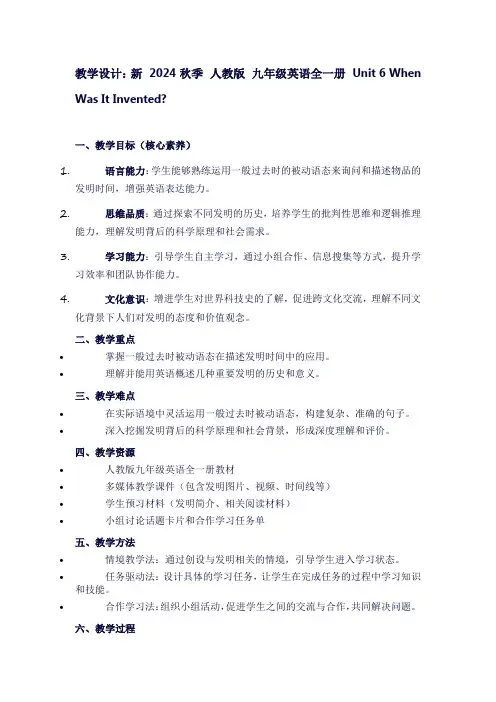
教学设计:新2024秋季人教版九年级英语全一册Unit 6 When Was It Invented?一、教学目标(核心素养)1.语言能力:学生能够熟练运用一般过去时的被动语态来询问和描述物品的发明时间,增强英语表达能力。
2.思维品质:通过探索不同发明的历史,培养学生的批判性思维和逻辑推理能力,理解发明背后的科学原理和社会需求。
3.学习能力:引导学生自主学习,通过小组合作、信息搜集等方式,提升学习效率和团队协作能力。
4.文化意识:增进学生对世界科技史的了解,促进跨文化交流,理解不同文化背景下人们对发明的态度和价值观念。
二、教学重点•掌握一般过去时被动语态在描述发明时间中的应用。
•理解并能用英语概述几种重要发明的历史和意义。
三、教学难点•在实际语境中灵活运用一般过去时被动语态,构建复杂、准确的句子。
•深入挖掘发明背后的科学原理和社会背景,形成深度理解和评价。
四、教学资源•人教版九年级英语全一册教材•多媒体教学课件(包含发明图片、视频、时间线等)•学生预习材料(发明简介、相关阅读材料)•小组讨论话题卡片和合作学习任务单五、教学方法•情境教学法:通过创设与发明相关的情境,引导学生进入学习状态。
•任务驱动法:设计具体的学习任务,让学生在完成任务的过程中学习知识和技能。
•合作学习法:组织小组活动,促进学生之间的交流与合作,共同解决问题。
六、教学过程•视频导入:播放一段关于科技发展的短片,展示人类历史上的重要发明,引发学生兴趣。
•提问互动:教师提问:“你们知道这些发明是什么时候被创造出来的吗?”引导学生思考并回答,自然过渡到本课主题。
新课教学1.词汇预热(可选)•展示与发明相关的词汇,如invention, inventor, create, discover等,学生跟读并尝试造句。
2.阅读理解(针对教材Section B的特定内容)•学生自主阅读教材文本,标注出文中提到的重要发明及其发明时间。
•教师引导学生通过快速阅读找到关键信息,理解文本大意。
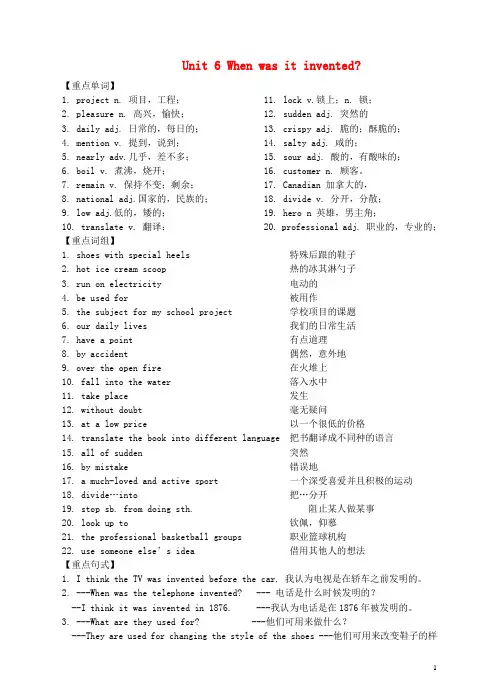
Unit 6 When was it invented? 【重点单词】1. project n. 项目,工程;2. pleasure n. 高兴,愉快;3. daily adj. 日常的,每日的;4. mention v. 提到,说到;5. nearly adv.几乎,差不多;6. boil v. 煮沸,烧开;7. remain v. 保持不变;剩余;8. national adj.国家的,民族的;9. low adj.低的,矮的;10. translate v. 翻译;11. lock v.锁上;n. 锁;12. sudden adj. 突然的13. crispy adj. 脆的;酥脆的;14. salty adj. 咸的;15. sour adj. 酸的,有酸味的;16. customer n. 顾客。
17. Canadian 加拿大的,18. divide v. 分开,分散;19. hero n 英雄,男主角;20. professional adj. 职业的,专业的;【重点词组】1. shoes with special heels 特殊后跟的鞋子2. hot ice cream scoop 热的冰其淋勺子3. run on electricity 电动的4. be used for 被用作5. the subject for my school project 学校项目的课题6. our daily lives 我们的日常生活7. have a point 有点道理8. by accident 偶然,意外地9. over the open fire 在火堆上10. fall into the water 落入水中11. take place 发生12. without doubt 毫无疑问13. at a low price 以一个很低的价格14. translate the book into different language 把书翻译成不同种的语言15. all of sudden 突然16. by mistake 错误地17. a much-loved and active sport 一个深受喜爱并且积极的运动18. divide…into 把…分开19. stop sb. from doing sth. 阻止某人做某事20. look up to 钦佩,仰慕21. the professional basketball groups 职业篮球机构22. use someone else’s idea 借用其他人的想法【重点句式】1. I think the TV was invented before the car. 我认为电视是在轿车之前发明的。
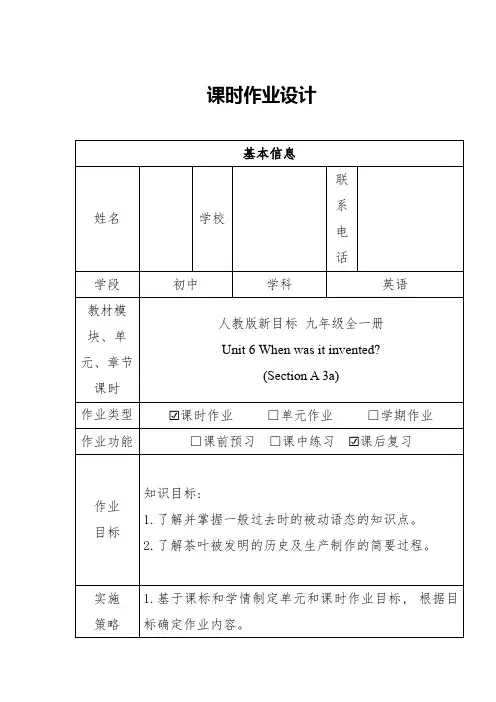
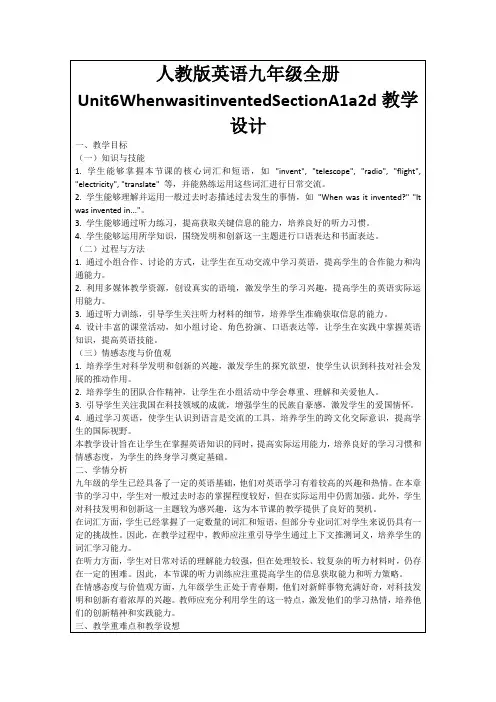
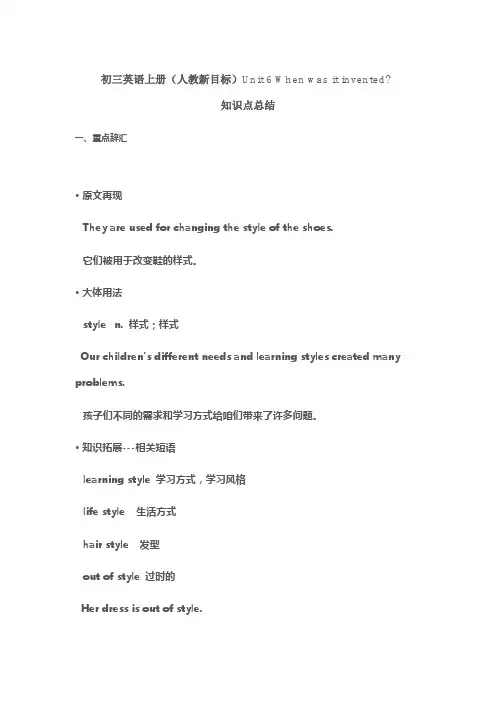
初三英语上册(人教新目标)Unit 6 When was it invented?知识点总结一、重点辞汇·原文再现They are used for changing the style of the shoes.它们被用于改变鞋的样式。
·大体用法style n. 样式;样式Our children's different needs and learning styles created many problems.孩子们不同的需求和学习方式给咱们带来了许多问题。
·知识拓展---相关短语learning style 学习方式,学习风格life style 生活方式hair style 发型out of style 过时的Her dress is out of style.她的穿着不时兴。
·原文再现The subject for my school project is "Small inventions that changed the world."学校课题的题目是:改变世界的小发明“·大体用法project n. 项目;工程Project Hope 希望工程The project will create up to 40 new jobs.这项工程将提供40个新的工作职位。
·知识拓展---其他词性project v. 计划(plan)The next edition of the book is projected for publication in March.本书的下一版计划于三月发行。
·原文再现--Can you help me think of an invention?你能帮忙我想一个发明吗?--My pleasure!我很荣幸。
·大体用法pleasure n. 高兴;愉快Watching sport gave him great pleasure.观看体育比赛给他以极大的愉悦。
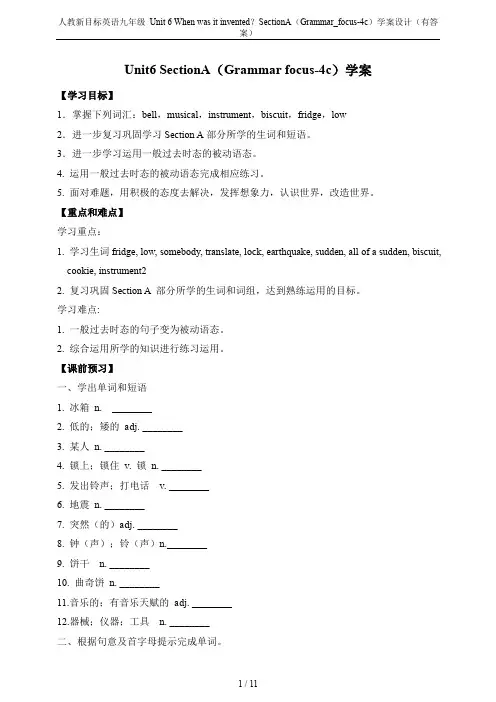
Unit6 SectionA(Grammar focus-4c)学案【学习目标】1.掌握下列词汇:bell,musical,instrument,biscuit,fridge,low2.进一步复习巩固学习Section A部分所学的生词和短语。
3.进一步学习运用一般过去时态的被动语态。
4. 运用一般过去时态的被动语态完成相应练习。
5. 面对难题,用积极的态度去解决,发挥想象力,认识世界,改造世界。
【重点和难点】学习重点:1. 学习生词fridge, low, somebody, translate, lock, earthquake, sudden, all of a sudden, biscuit, cookie, instrument22. 复习巩固Section A 部分所学的生词和词组,达到熟练运用的目标。
学习难点:1. 一般过去时态的句子变为被动语态。
2. 综合运用所学的知识进行练习运用。
【课前预习】一、学出单词和短语1. 冰箱n. ________2. 低的;矮的adj. ________3. 某人n. ________4. 锁上;锁住v. 锁n. ________5. 发出铃声;打电话v. ________6. 地震n. ________7. 突然(的)adj. ________8. 钟(声);铃(声)n.________9. 饼干n. ________10. 曲奇饼n. ________11.音乐的;有音乐天赋的adj. ________12.器械;仪器;工具n. ________二、根据句意及首字母提示完成单词。
1. Food is put in the f_________ to keep fresh.2. The music was so beautiful, it went high and l_________, up and down.3. The book was t___________ into different languages.4. When I got to my classroom, I found the door was l_________. So I had to wait for half an hour until they came.5. Most of the buildings and trees fell down after the e__________.【合作探究】探究一、一般过去时被动语态的结构观察下面例句总结被动语态的结构。
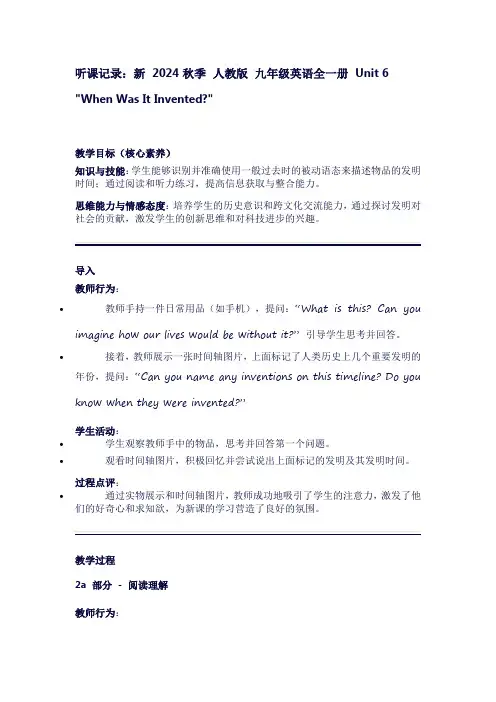
听课记录:新2024秋季人教版九年级英语全一册Unit 6 "When Was It Invented?"教学目标(核心素养)知识与技能:学生能够识别并准确使用一般过去时的被动语态来描述物品的发明时间;通过阅读和听力练习,提高信息获取与整合能力。
思维能力与情感态度:培养学生的历史意识和跨文化交流能力,通过探讨发明对社会的贡献,激发学生的创新思维和对科技进步的兴趣。
导入教师行为:•教师手持一件日常用品(如手机),提问:“What is this? Can you imagine how our lives would be without it?” 引导学生思考并回答。
•接着,教师展示一张时间轴图片,上面标记了人类历史上几个重要发明的年份,提问:“Can you name any inventions on this timeline? Do you know when they were invented?”学生活动:•学生观察教师手中的物品,思考并回答第一个问题。
•观看时间轴图片,积极回忆并尝试说出上面标记的发明及其发明时间。
过程点评:•通过实物展示和时间轴图片,教师成功地吸引了学生的注意力,激发了他们的好奇心和求知欲,为新课的学习营造了良好的氛围。
教学过程2a 部分- 阅读理解教师行为:•引导学生阅读2a部分的短文,要求他们边读边标记出文中提到的发明名称、发明者和发明时间。
•完成后,教师提问几个学生,检查他们的阅读成果,并引导学生总结文章大意。
学生活动:•学生认真阅读短文,标记关键信息。
•积极回答问题,分享自己的阅读理解和总结。
过程点评:•通过阅读理解和信息提取活动,学生不仅锻炼了阅读技能,还加深了对一般过去时被动语态的理解和应用。
2b 部分- 听力理解教师行为:•播放与2a部分短文相关的听力材料,要求学生在听的过程中完成2b部分的匹配题。
•播放结束后,检查答案,并针对错误进行解析和纠正。
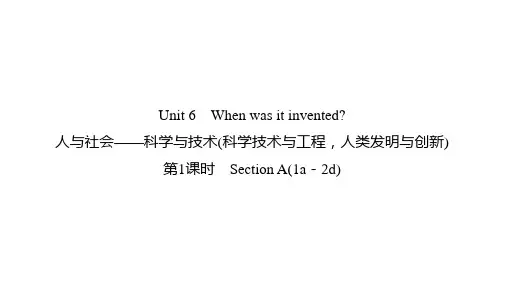
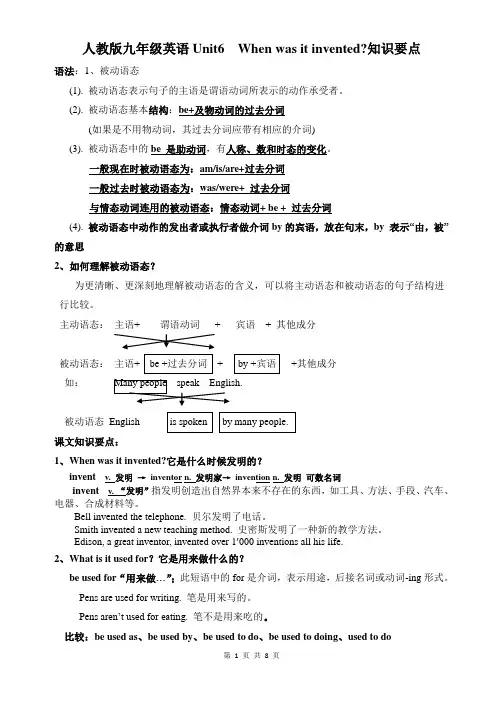
人教版九年级英语Unit6 When was it invented?知识要点语法:1、被动语态(1). 被动语态表示句子的主语是谓语动词所表示的动作承受者。
(2). 被动语态基本结构:be+及物动词的过去分词(如果是不用物动词,其过去分词应带有相应的介词)(3). 被动语态中的be 是助动词,有人称、数和时态的变化。
一般现在时被动语态为:am/is/are+过去分词一般过去时被动语态为:was/were+ 过去分词与情态动词连用的被动语态:情态动词+ be + 过去分词(4). 被动语态中动作的发出者或执行者做介词by的宾语,放在句末,by 表示“由,被”的意思2、如何理解被动语态?为更清晰、更深刻地理解被动语态的含义,可以将主动语态和被动语态的句子结构进行比较。
主动语态:主语+ 谓语动词+ 宾语+ 其他成分被动语态:主语+ be +过去分词+ by +宾语+其他成分如:被动语态English is spoken by many people.课文知识要点:1、When was it invented?它是什么时候发明的?invent v. 发明→inventor n. 发明家→invention n. 发明可数名词invent v. “发明”指发明创造出自然界本来不存在的东西,如工具、方法、手段、汽车、电器、合成材料等。
Bell invented the telephone. 贝尔发明了电话。
Smith invented a new teaching method. 史密斯发明了一种新的教学方法。
Edison, a great inventor, invented over 1’000 inventions all his life.2、What is it used for?它是用来做什么的?be used for“用来做…”;此短语中的for是介词,表示用途,后接名词或动词-ing形式。
人教版九年级英语《Unit 6 When was it invented?》教学设计一. 教材分析人教版九年级英语《Unit 6 When was it invented?》主要介绍了与日常生活相关的科学技术发明的历史。
本单元包括一般过去时的被动语态,以及表示过去某段时间经常发生的动作或存在的状态的用法。
本节课旨在让学生掌握一般过去时的被动语态,能够运用本课所学内容进行交流。
二. 学情分析九年级的学生已经具备了一定的英语基础,能够听、说、读、写简单的英语句子。
但部分学生在语言表达方面仍有困难,需要教师的耐心引导和鼓励。
此外,学生对于科技发明的历史知识了解有限,需要在教学过程中进行补充。
三. 教学目标1.知识目标:–掌握一般过去时的被动语态。
–了解与日常生活相关的科学技术发明的历史。
2.能力目标:–能够运用一般过去时的被动语态进行交流。
–提高学生的听说读写能力。
3.情感目标:–激发学生对科学技术发展的兴趣。
–培养学生的创新意识。
四. 教学重难点•一般过去时的被动语态。
•与日常生活相关的科学技术发明的历史。
•一般过去时的被动语态的运用。
•对科学技术发明历史的理解。
五. 教学方法1.情境教学法:通过设定情境,让学生在实际语境中学习、运用英语。
2.交际法:引导学生进行互动交流,提高口语表达能力。
3.任务型教学法:通过完成任务,培养学生综合运用英语的能力。
4.启发式教学法:引导学生主动思考,激发学习兴趣。
六. 教学准备1.教材:人教版九年级英语《Unit 6 When was it invented?》。
2.辅助材料:科技发明历史的相关图片、视频等。
3.多媒体设备:投影仪、电脑等。
4.教学卡片:一般过去时的被动语态的句子。
七. 教学过程1.导入(5分钟)利用图片或视频介绍科学技术发明的历史,激发学生的兴趣。
引导学生谈论自己了解的科技发明,复习一般过去时。
2.呈现(10分钟)展示本节课的主要内容,引导学生关注一般过去时的被动语态。
人教版九年级英语《Unit 6 When was it invented?》说课稿一. 教材分析人教版九年级英语《Unit 6 When was it invented?》是本单元的第一课时,主要讲述过去时态的疑问句以及一般过去时的被动语态。
本节课主要通过介绍一些发明的起源时间,让学生掌握过去时疑问句的构成以及一般过去时的被动语态的运用。
教材内容丰富,插图生动有趣,激发了学生学习的兴趣。
二. 学情分析九年级的学生已经掌握了基本的英语语法知识,具备一定的阅读和写作能力。
但是,对于过去时疑问句和一般过去时的被动语态的运用还存在一定的困难。
因此,在教学过程中,需要注重引导学生掌握这些语法知识,并通过大量的练习来提高他们的语言运用能力。
三. 说教学目标1.知识目标:让学生掌握过去时疑问句的构成以及一般过去时的被动语态的运用。
2.能力目标:通过听力、口语、阅读和写作的练习,提高学生运用过去时疑问句和一般过去时的被动语态进行交流的能力。
3.情感目标:激发学生学习英语的兴趣,培养他们积极向上的学习态度。
四. 说教学重难点1.教学重点:过去时疑问句的构成以及一般过去时的被动语态的运用。
2.教学难点:一般过去时的被动语态的运用。
五. 说教学方法与手段1.教学方法:采用任务型教学法,通过听力、口语、阅读和写作的练习,让学生在实际语境中掌握过去时疑问句和一般过去时的被动语态的运用。
2.教学手段:利用多媒体课件、图片、卡片等教学辅助工具,激发学生的学习兴趣,提高课堂活力。
六. 说教学过程1.导入:通过展示一些常见的发明图片,引导学生谈论这些发明的起源时间,从而引入本节课的主题。
2.新课呈现:通过多媒体课件,展示本节课的主要内容,引导学生观察并发现过去时疑问句的构成以及一般过去时的被动语态的运用。
3.语法讲解:通过示例和讲解,让学生明确过去时疑问句的构成和一般过去时的被动语态的运用规则。
4.小组讨论:学生分组进行讨论,运用过去时疑问句和一般过去时的被动语态进行交流,巩固所学知识。
学科English 课时 5 年级9年级课题Unit 6 When was it invented? 5/5
教学要求1. Learn some new words: 2.Talk about the history of the basketball.3.Be able to use the strategy( mind-mapping)to read a passage.
教学重难点1.Key vocabulary.
2.Read the text to identify main
idea.
3.Read the text to understand words
in context.
教
法
任务型教学法
分组学习法
五指教学法
教学过程及问题情境学生活动设计意图
Step1. Revision
Ask some students some questions about target language.
Step 2 Presentation
Before you read
Ⅰ1a 1. People like sports because it can keep them fit and make them relaxing. Do you like doing sports?
2. How many kinds of sports do you know? Answer the
questions.
Answer some
questions and
list eight
sports played
in China.
通过问题方
式复习已学
知识。
完成相应的
任务,导入新
课
3.Look at some pictures. There are so many kinds of sports.
Discuss in pairs. List eight sports played in China. And fill in the chart.
Ⅱ1b
1.Do you think which sport is
the most popular?
2.2.which one do you think is
less popular? 3.Ask students to rank the sports they listed in the order of popularity. While you read
ⅠShow a picture of Yao Ming, and ask some questions.
Do you know him?
ⅡRead this article and answer some questions.
How was the basketball invented?
After you read
Ⅰ.3a. Complete the mind-map 3.Rank the
sports
they
listed in
the order
of
popularity
.
Understandin
g the article
and answer
some
questions.
Complete the。
完成阅读任
务,提高阅读
能力。
训练学生利
用思路图理
解文章,记住
信息,回答相
应的问题。
with information from the reading. First discuss in groups. Then check the answers. Ⅱ.3b Without reading the article again, use what you remember from the mind-map to answer the following questions. 1.Who invented basketball?
2. Why were the Berlin Olympics important for basketball?
3. What is the aim of basketball?
4.
Name
a
professional basketball organization in America.
Ⅲ. 4. Go For It!
Ⅰ.Ask some questions first. (1)Do
you
like
playing basketball?
(2)Do you want to be a professional basketball player like Yao Ming? (3)would mind-map with information from the reading. Answer the following questions.
Answer the
questions
first ,then discuss in groups to make a list of
good things
and difficult
things about being a basketball
阅读文章后,
询问学生他们认为成为一名篮球运动员是难还是易,发表个人见解。
you like to play on China’s
national basketball team one
day? (4)Is it good to be a basketball player? 2.Ask the
students to discuss in groups to
make a list of good things and
difficult things about being a basketball players. Fill in the
chart.
3.Ask the students to tell their
idea.
Step 3 Summary
players. 作
业布置Homework: Review what we have learned this unit. Prepare for a test.
教学反思。